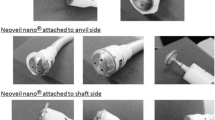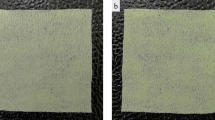Abstract
Side-to-side anastomoses are more frequently performed. This method is relatively simple, timesaving, and can be applied in a variety of settings where anastomoses are necessary. Despite some advances, stapled anastomoses have inherent weak points. With any type of side-to-side anastomosis, the crotch is formed at the tip portion of the stapler; this crotch area is the weak point. We describe a novel surgical technique for side-to-side anastomosis using a reinforced crotch. After distal gastrectomy, a small incision was made on the greater curvature of the remnant stomach and the posterior side of the duodenum. We use a 60-mm linear stapler, namely, the Endo GIATM Reinforce Reload (Covidien Japan). Therefore, the stapler length inserted into the stomach and duodenum is 45 mm. The reinforce reloads have a preloaded reinforcement material on the both anvil and cartridge. One or two supporting sutures were added to the center of the common enterotomy. Pulling up on the two pieces of Neoveil® and the sutures, the common enterotomy was closed with a linear stapler. Delta-shaped anastomosis is then accomplished. We also use a reinforced reload in a side-to-side anastomosis between two segments of jejunum. Neoveil® is thin and soft; we found no problem using either a hand thrown suture or stapler to close the entry hole. In fact, we found that the excess Neoveil® is very useful. Neoveil® can be a substitute for the sutures. Only one or two hand thrown sutures were then necessary to close the common enterotomy. And we do not add the reinforce suture of the crotch at all. This novel method is a simple and useful method and can be used in side-to-side anastomoses in a variety of settings.




Similar content being viewed by others
References
Lee S, Nomura E, Tokuhara T et al (2011) Laparoscopic technique and initial experience with knotless, unidirectional barbed suture closure for staple-conserving, delta-shaped gastrectomy after distal gastrectomy. J Am Coll Surg 213:e39–e45
Noshiro H, Iwasaki H, Miyasaka Y et al (2011) An additional suture against pitfalls in delta-shaped gastroduodenostomy after laparoscopic distal gastrectomy. Gastric cancer 14:385–389
Kanaya S, Kawamura Y, Kawada H et al (2011) The delta-shaped anastomosis in laparoscopic distal gastrectomy: analysis of the initial 100 consecutive procedure of intracorporeal gastroduodenostomy. Gastric cancer 14:365–371
Huang CM, Lin M, Lin JX et al (2014) Comparison of modified and conventional delta-shaped gastroduodenostomy in totally laparoscopic surgery. World J Gastroenterol 20:10478–10485
Huang C, Lin M, Chen Q et al (2014) A modified delta-shaped gastroduodenostomy in totally laparoscopic distal gastrectomy for gastric cancer: a safe and feasible technique. PLoS One 9:e102736
Oki E, Tsuda Y, Saeki H et al (2014) Book-binding technique for Billroth I anastomosis during totally laparoscopic distal gastrectomy. J Am Coll Surg 219:e69–e73
Fujimoto H, Kimura W, Takahashi R et al (2015) A new attempt to use staples for gastrojejunostomy and Braun anastomosis in modified child method of pancreaticoduodenectomy. Yamagata Med J 33:91–96
Takaori K, Nomura E, Mabuchi H et al (2005) A secure technique of intracorporeal Roux-Y reconstruction after laparoscopic distal gastrectomy. Am J Surg 189:178–183
Saber AA, Scharf KR, Turk AZ et al (2008) Early experience with intraluminal reinforcement of stapled gastrojejunostomy during laparoscopic Roux-En-Y gastric bypass. Obes Surg 18:525–529
Kanaya S, Gomi T, Momoi H et al (2002) Delta-shaped anastomosis in totally laparoscopic Billroth I gastrectomy: new technique of intraabdominal gastrectomy. J Am Coll Surg 195:284–287.12
Liu Z, Wang G, Yang M et al (2014) Ileocolonic anastomosis after right hemicolectomy for colon cancer: functional end-to-end or end-to-side? World J Surg Oncol 12:306–310
Goto T, Kawasaki K, Fujino Y et al (2007) Evaluation of the mechanical and patency of functional end-to-end anastomoses. Surg Endosc 21:1508–1511
Author information
Authors and Affiliations
Corresponding author
Rights and permissions
About this article
Cite this article
Kimura, M., Shibata, Y. & Mori, Y. Novel Attempt Using Bioabsorbable Reinforcement Material on the Crotch of a Side-to-Side Anastomosis. Indian J Surg 80, 559–563 (2018). https://doi.org/10.1007/s12262-017-1662-7
Received:
Accepted:
Published:
Issue Date:
DOI: https://doi.org/10.1007/s12262-017-1662-7




